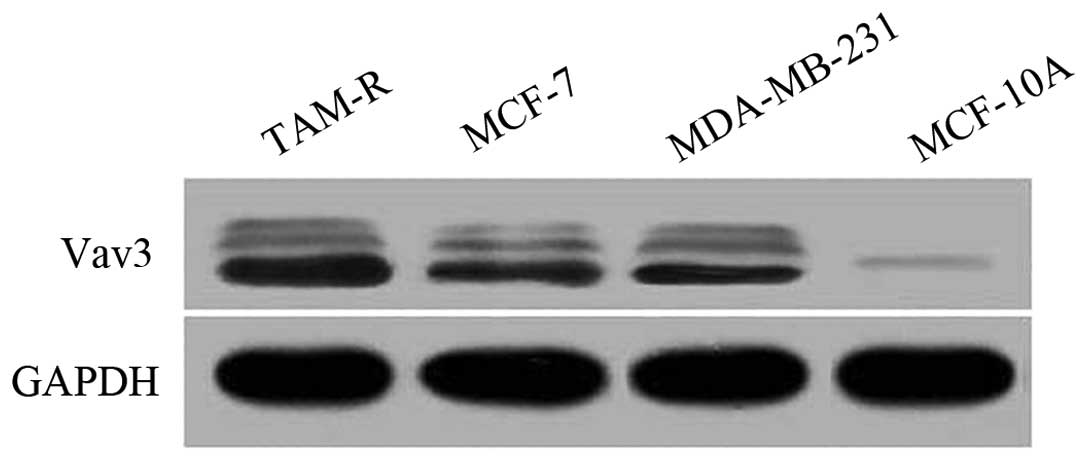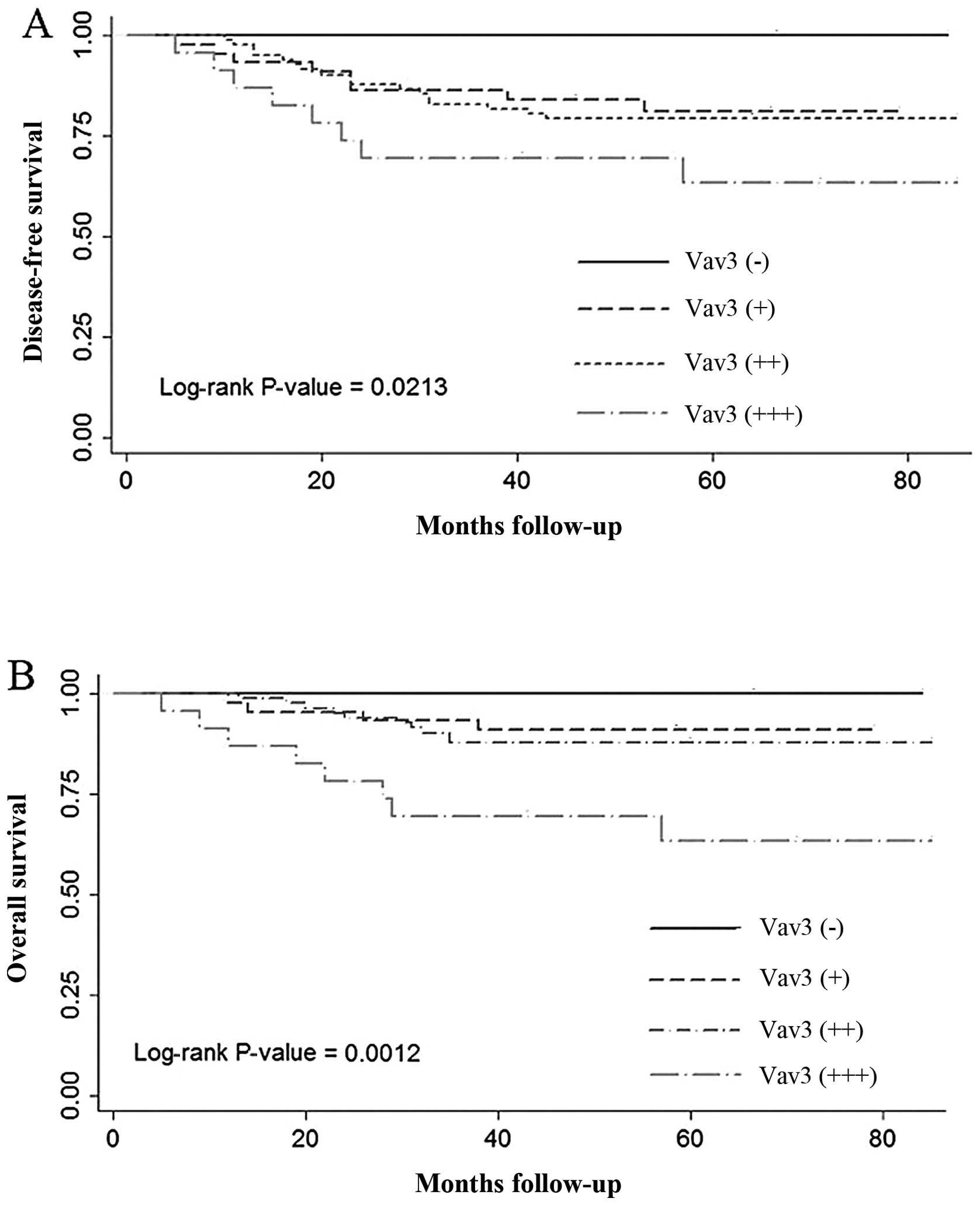|
1
|
Parkin DM, Bray F, Ferlay J and Pisani P:
Global cancer statistics, 2002. CA Cancer J Clin. 55:74–108. 2005.
View Article : Google Scholar : PubMed/NCBI
|
|
2
|
Bustelo XR: The VAV family of signal
transduction molecules. Crit Rev Oncog. 7:65–88. 1996. View Article : Google Scholar : PubMed/NCBI
|
|
3
|
Van Aelst L and D'Souza-Schorey C: Rho
GTPases and signaling networks. Genes Dev. 11:2295–2322. 1997.
View Article : Google Scholar : PubMed/NCBI
|
|
4
|
Katzav S, Martin-Zanca D and Barbacid M:
vav, a novel human oncogene derived from a locus ubiquitously
expressed in hematopoietic cells. EMBO J. 8:2283–2290.
1989.PubMed/NCBI
|
|
5
|
Zugaza JL, Lopez-Lago MA, Caloca MJ, Dosil
M, Movilla N and Bustelo XR: Structural determinants for the
biological activity of Vav proteins. J Biol Chem. 277:45377–45392.
2002. View Article : Google Scholar : PubMed/NCBI
|
|
6
|
Bustelo XR: Regulatory and signaling
properties of the Vav family. Mol Cell Biol. 20:1461–1477. 2000.
View Article : Google Scholar : PubMed/NCBI
|
|
7
|
Lyons LS and Burnstein KL: Vav3, a Rho
GTPase guanine nucleotide exchange factor, increases during
progression to androgen independence in prostate cancer cells and
potentiates androgen receptor transcriptional activity. Mol
Endocrinol. 20:1061–1072. 2006. View Article : Google Scholar : PubMed/NCBI
|
|
8
|
Dong Z, Liu Y, Lu S, et al: Vav3 oncogene
is overexpressed and regulates cell growth and androgen receptor
activity in human prostate cancer. Mol Endocrinol. 20:2315–2325.
2006. View Article : Google Scholar : PubMed/NCBI
|
|
9
|
Rosenblatt AE, Garcia MI, Lyons L, et al:
Inhibition of the Rho GTPase, Rac1, decreases estrogen receptor
levels and is a novel therapeutic strategy in breast cancer. Endoc
Relat Cancer. 18:207–219. 2011.
|
|
10
|
Loss LA, Sadanandam A, Durinck S, et al:
Prediction of epigenetically regulated genes in breast cancer cell
lines. BMC Bioinformatics. 11:3052010. View Article : Google Scholar : PubMed/NCBI
|
|
11
|
Sauter G, Simon R and Hillan K: Tissue
microarrays in drug discovery. Nat Rev Drug Discov. 2:962–972.
2003. View
Article : Google Scholar : PubMed/NCBI
|
|
12
|
Torhorst J, Bucher C, Kononen J, et al:
Tissue microarrays for rapid linking of molecular changes to
clinical endpoints. Am J Pathol. 159:2249–2256. 2001. View Article : Google Scholar : PubMed/NCBI
|
|
13
|
Nocito A, Bubendorf L, Tinner EM, et al:
Microarrays of bladder cancer tissue are highly representative of
proliferation index and histological grade. J Pathol. 194:349–357.
2001. View Article : Google Scholar : PubMed/NCBI
|
|
14
|
Moch H, Schraml P, Bubendorf L, et al:
High-throughput tissue microarray analysis to evaluate genes
uncovered by cDNA microarray screening in renal cell carcinoma. Am
J Pathol. 154:981–986. 1999. View Article : Google Scholar : PubMed/NCBI
|
|
15
|
Kononen J, Bubendorf L, Kallioniemi A, et
al: Tissue microarrays for high-throughput molecular profiling of
tumor specimens. Nat Med. 4:844–847. 1998. View Article : Google Scholar : PubMed/NCBI
|
|
16
|
Salhia B, Tran NL, Chan A, et al: The
guanine nucleotide exchange factors trio, Ect2 and Vav3 mediate the
invasive behavior of glioblastoma. Am J Pathol. 173:1828–1838.
2008. View Article : Google Scholar : PubMed/NCBI
|
|
17
|
Zeng L, Sachdev P, Yan L, et al: Vav3
mediates receptor protein tyrosine kinase signaling, regulates
GTPase activity, modulates cell morphology and induces cell
transformation. Mol Cell Biol. 20:9212–9224. 2000. View Article : Google Scholar : PubMed/NCBI
|
|
18
|
Palmby TR, Abe K, Karnoub AE and Der CJ:
Vav transformation requires activation of multiple GTPases and
regulation of gene expression. Mol Cancer Res. 2:702–711.
2004.PubMed/NCBI
|
|
19
|
Hunter SG, Zhuang G, Brantley-Sieders D,
Swat W, Cowan CW and Chen J: Essential role of Vav family guanine
nucleotide exchange factors in EphA receptor-mediated angiogenesis.
Mol Cell Biol. 26:4830–4842. 2006. View Article : Google Scholar : PubMed/NCBI
|
|
20
|
Fang WB, Brantley-Sieders DM, Hwang Y, Ham
AJ and Chen J: Identification and functional analysis of
phosphorylated tyrosine residues within EphA2 receptor tyrosine
kinase. J Biol Chem. 283:16017–16026. 2008. View Article : Google Scholar : PubMed/NCBI
|
|
21
|
Vollenweider-Zerargui L, Barrelet L, Wong
Y, Lemarchand-Beraud T and Gomez F: The predictive value of
estrogen and progesterone receptors' concentrations on the clinical
behavior of breast cancer in women. Clinical correlation on 547
patients. Cancer. 57:1171–1180. 1986. View Article : Google Scholar : PubMed/NCBI
|
|
22
|
Viale G, Regan MM, Maiorano E, et al:
Prognostic and predictive value of centrally reviewed expression of
estrogen and progesterone receptors in a randomized trial comparing
letrozole and tamoxifen adjuvant therapy for postmenopausal early
breast cancer: BIG 1–98. J Clin Oncol. 25:3846–3852. 2007.
View Article : Google Scholar : PubMed/NCBI
|
|
23
|
Altan E and Altundag K: Clinical and
pathological characteristics of occult breast cancer and review of
the literature. J BUON. 16:434–436. 2011.PubMed/NCBI
|
|
24
|
Colleoni M, Rotmensz N, Robertson C, et
al: Very young women (<35 years) with operable breast cancer:
features of disease at presentation. Ann Oncol. 13:273–279. 2002.
View Article : Google Scholar : PubMed/NCBI
|












